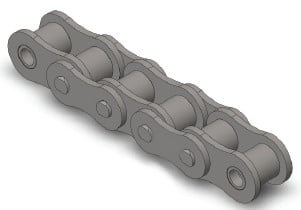Roller chains are one particular on the most productive and value eff ective approaches to transmit mechanical electrical power in between shafts. They operate over a wide selection of speeds, manage significant operating loads, have very little vitality losses and therefore are generally affordable in contrast with other techniques
of transmitting power. Productive choice will involve following several relatively simple steps involving algebraic calculation along with the utilization of horsepower and support element tables.
For just about any offered set of drive disorders, there are a number of possible chain/sprocket confi gurations which can effectively operate. The designer thus must be aware of quite a few essential choice concepts that when utilized properly, assist stability overall drive efficiency and expense. By  following the steps outlined in this area designers should be in a position to make choices that meet the prerequisites in the drive and therefore are cost eff ective.
following the steps outlined in this area designers should be in a position to make choices that meet the prerequisites in the drive and therefore are cost eff ective.
Standard Roller Chain Drive Ideas
? The proposed quantity of teeth for the little sprocket is 15. The minimum is 9 teeth – smoother operation is obtained with a lot more teeth.
? The advisable greatest number of teeth for your huge sprocket is 120. Note that even though extra teeth will allow for smoother operation possessing as well many teeth leads to chain jumping off the sprocket soon after a somewhat modest amount of chain elongation due to wear – That is chains with a pretty large number of teeth accommodate much less dress in in advance of the chain will no longer wrap about them properly.
? Speed ratios should be seven:1 or less (optimum) and never higher
than 10:one. For bigger ratios the use of multiple chain reductions is suggested.
? The advised minimum wrap of the compact sprocket is 120°.
? The proposed center distance among shafts is 30-50 pitches of chain. You can find two exceptions to this as follows:
one. The center distance has to be better than the sum with the outside diameters in the driver and driven sprockets to prevent interference.
2. For speed ratios higher than 3:one the center distance should not be much less compared to the outdoors diameter of your big sprocket minus the outside diameter on the smaller sprocket to assure a minimal 120° wrap about the compact sprocket.
